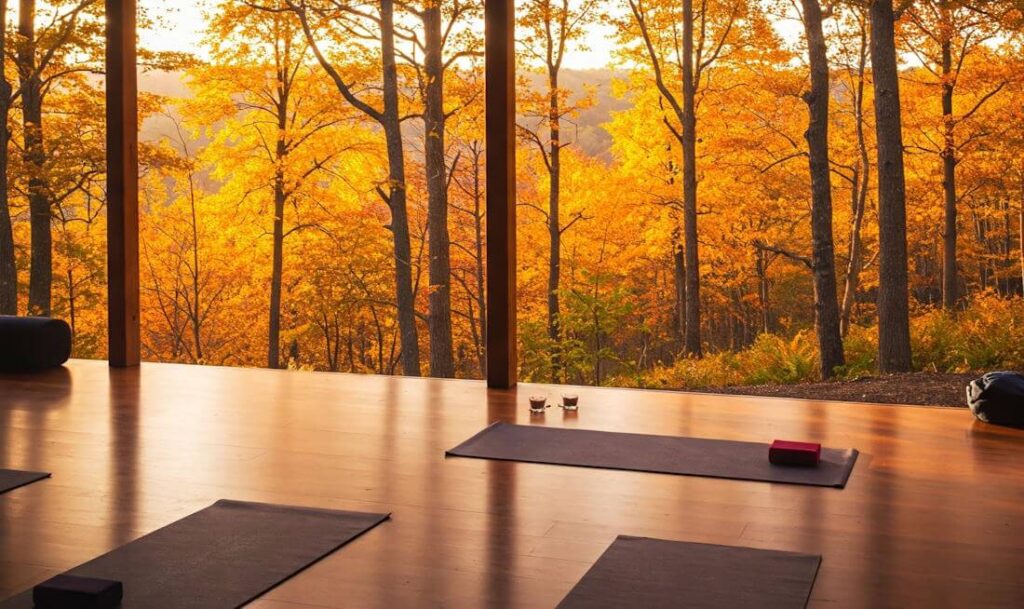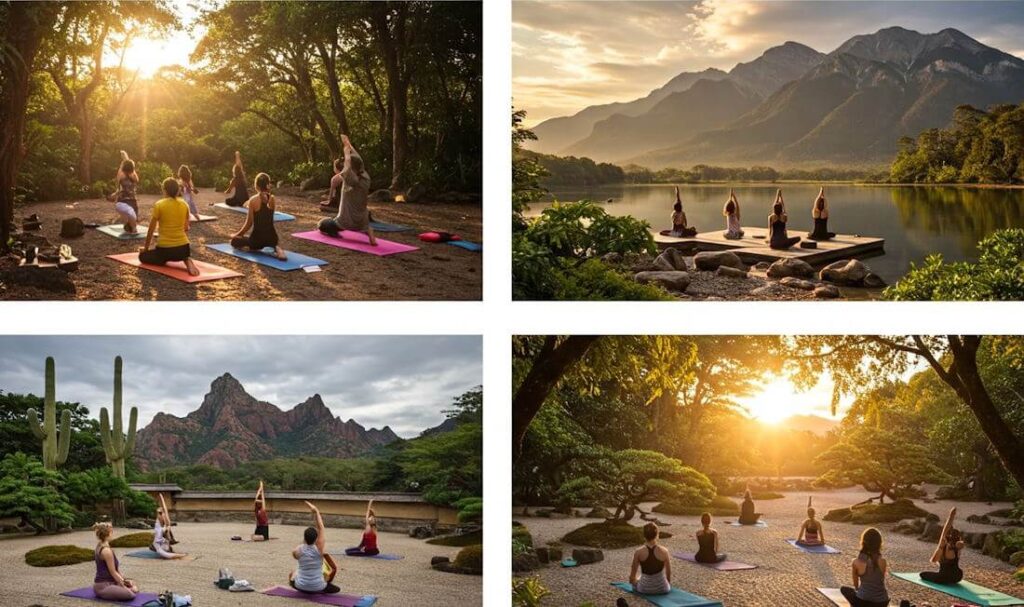Yoga retreats have gained significant popularity in recent years, attracting individuals seeking a deeper engagement with their yoga practice and an opportunity to rejuvenate both body and mind. Typically held in serene environments away from the hustle and bustle of daily life, these retreats offer participants a chance to immerse themselves in yoga, meditation, and holistic wellness. The primary purpose of a yoga retreat is to provide a space for self-discovery, relaxation, and healing, allowing attendees to step back from their everyday responsibilities and reconnect with themselves.
Yoga retreats vary widely in focus, duration, and location, catering to diverse needs and interests. Some retreats are designed for advanced practitioners who wish to hone their skills or explore specific yoga styles, while others may accommodate beginners seeking a gentle introduction to the practice. Additionally, a range of themed retreats exists, such as those centered around detoxification, spiritual growth, or nurturing creativity. This variety ensures that individuals can find a yoga retreat that resonates with their personal goals and aspirations.
The growing interest in wellness and self-care has propelled yoga retreats into the mainstream, transforming them into a valuable asset for individuals looking to enhance their physical and mental well-being. As the demand for such experiences increases, many people are now considering the best time of year to attend these retreats. Seasonal variations can affect the atmosphere and activities available, making it essential for potential attendees to evaluate when they can maximize their retreat experience. Understanding when to participate can significantly influence the overall benefits derived from these transformative experiences, helping individuals attain a sense of balance and tranquility.
Spring: A Time for Renewal
Spring is often regarded as a season of renewal and growth, making it an ideal time for attending a yoga retreat. As nature awakens from its winter slumber, participants can immerse themselves in vibrant surroundings bursting with life. The moderate temperatures and blooming flora create a tranquil setting that enhances the overall yoga experience. During this season, many retreats offer outdoor classes that allow practitioners to connect more deeply with nature. The fresh air and renewal of energy during spring align with the philosophical principles of yoga, promoting both physical and mental rejuvenation.
Summer: Embracing Energy and Vitality
The summer months are characterized by warmth and long daylight hours, providing an energetic backdrop for yoga retreats. Participants can take advantage of diverse outdoor activities, such as hiking or swimming, which often complement yoga practice. The sun’s rays are also thought to uplift mood, fostering a sense of positivity and vitality among retreat attendees. Many locations host beach retreats or nature-focused sessions during summer, offering the chance to harmonize yoga movements with the sounds and sights of nature. This connection can deepen participants’ practice, encouraging them to explore more dynamic types of yoga.
Autumn: Embracing Change
As the seasons shift towards autumn, participants at yoga retreats can witness the beauty of changing leaves and appreciate the symbolism of transformation. This season is often associated with introspection, making it an excellent time for deeper meditation practices. Cooler temperatures create a cozy atmosphere, enhancing the feeling of safety and mindfulness during yoga sessions. Many retreats incorporate elements of seasonal harvests, allowing for fresh, locally sourced meals to nourish practitioners, further promoting holistic wellness. The essence of autumn resonates well with yoga’s focus on self-discovery and awareness.
Winter: Cultivating Inner Peace
Winter brings a unique opportunity for growth through introspection and self-care, making it a perfect season for attending a yoga retreat. The cold temperatures prompt individuals to seek warmth and comfort, often creating a serene, contemplative atmosphere at retreats. Participants often engage in restorative yoga practices designed to promote relaxation and inner peace, helping to combat the stresses that often accompany this season. Additionally, many retreats provide cozy amenities such as fireside gatherings, allowing practitioners to bond with like-minded individuals. The focus on self-care during winter is vital for recharging and preparing for the upcoming year.
Spring Retreats: Rejuvenation and Renewal
As winter yields to the gentle warmth of spring, this season emerges as a prime time for individuals seeking rejuvenation and renewal through yoga retreats. Spring symbolizes new beginnings, making it an ideal backdrop for those wishing to reset their intentions and reconnect with their inner selves. The moderate climate during this period allows retreat participants to engage in yoga practices outdoors, fostering a deeper connection to the natural environment and promoting mindfulness.
The blossoming beauty of nature in spring enhances the retreat experience significantly. As flowers bloom and trees regain their lush foliage, the vibrant colors and fresh scents create a serene atmosphere conducive to meditation and introspection. The natural world awakens during this season, mirroring the inner awakening many participants seek. By immersing oneself in such revitalizing surroundings, individuals can cultivate a clearer mind and a more open heart, essential for personal growth and spiritual exploration.
Moreover, spring retreats provide an excellent opportunity to set intentions for the year ahead. This season often encourages individuals to reflect on their goals and aspirations, making it a powerful time for self-discovery. Yoga practices during retreats—inclusive of asanas, pranayama, and meditation—offer tools that help clarify these intentions, allowing participants to create actionable steps toward achieving their goals. The supportive environment created by teachers and fellow attendees fosters camaraderie and collective growth, enhancing the overall retreat experience.
In summary, spring yoga retreats not only promote physical well-being but also serve as a catalyst for personal transformation. The season’s themes of rejuvenation and renewal, combined with the supportive atmosphere of a yoga retreat, make it an optimal time for individuals to engage in reflective practices and set meaningful intentions.
Summer Retreats: Embracing Energy and Connection
Summer yoga retreats provide a unique opportunity for practitioners to cultivate their yoga practice amidst an environment characterized by warmth and vibrant energy. During the summer months, the longer days and favorable weather conditions facilitate outdoor yoga sessions, where participants can immerse themselves in nature while engaging in their practice. This setting is not only conducive to physical postures but also fosters a sense of connection with the natural world, enhancing the overall experience of the retreat.
One of the distinctive advantages of summer retreats is the communal atmosphere they promote. With longer daylight hours, participants are encouraged to engage in group activities and social gatherings, enabling them to forge meaningful connections with fellow attendees. This camaraderie often leads to a supportive community, where individuals can share experiences, insights, and challenges related to their yoga journey. The collaborative environment is ideal for those looking to deepen their practice through shared knowledge and encouragement.
In addition to the physical benefits derived from practicing yoga in a warm climate, summer retreats often incorporate various activities that align with the increased energy of the season. Participants may have the opportunity to partake in workshops, meditation sessions, and outdoor adventures, all designed to enhance their holistic well-being. These immersive experiences further contribute to the rejuvenating aspect of summer yoga retreats, making them a transformative period for personal growth.
Moreover, many retreats offer a diverse range of practices and styles, catering to different levels of experience. This inclusivity enables both novice and seasoned yogis to feel welcome and supported, ultimately enriching their overall experience. In essence, summer yoga retreats not only enhance one’s physical practice but also nurture social connections, making this time of year an ideal choice for those seeking both personal and communal growth.
Autumn Retreats: Reflection and Letting Go
Autumn, with its vibrant hues and cooler breezes, stands as a significant season for introspection and renewal, making it an opportune time for yoga retreats. As trees shed their leaves, symbolizing a natural cycle of letting go, individuals are encouraged to reflect upon their personal journeys and release what no longer serves them. This aspect of transition resonates deeply with the principles of yoga, which often emphasizes the importance of surrender and awareness in one’s practice.
During this time of year, the environment itself invites participants to engage in a deeper level of self-exploration. The fading daylight and the gradual onset of winter create a backdrop ideal for contemplation. Yogic practices that prioritize mindfulness and meditation align seamlessly with the autumnal theme of turning inward, allowing retreat-goers to embrace the stillness and clarity that comes along with the season. This reflective process helps individuals assess their personal growth and redefine their intentions as they prepare for the colder months ahead.
Additionally, autumn retreats offer unique opportunities for connection with nature. Outdoor yoga sessions can be imbued with the rich scents of fallen leaves and the crispness of the air, fostering a profound sense of grounding and connectedness. Such experiences not only enhance physical wellness but also encourage emotional healing as participants become more attuned to the cycles of life around them. Workshops focused on letting go and embracing change can further enrich the retreat experience, as attendees learn to navigate their evolving landscapes with grace and acceptance.
Incorporating seasonal themes into yoga practices and discussions can provide valuable insights and support during a time when many feel the urge to evaluate their lives more critically. Therefore, an autumn yoga retreat stands as a compelling invitation to delve into the practice of letting go and embracing transition, enhancing one’s overall well-being as winter approaches.
Winter Retreats: Introspection and Inner Peace
Winter is often regarded as a season of rest and reflection, making it an opportune time to attend a yoga retreat. As the days grow shorter and temperatures drop, many individuals seek warmth not only in the climate but also in their hearts and minds. A winter yoga retreat offers a unique environment conducive to introspection and personal growth, providing participants with the opportunity to turn inward and cultivate a sense of inner peace amidst the hustle and bustle of everyday life.
The colder months encourage us to slow down and find solace in our routines. Engage in daily yoga practice at a winter retreat allows individuals to reconnect with themselves, fostering mindfulness and awareness. The serene surroundings typically found in winter retreats, whether they’re nestled in snowy mountains or peaceful woodlands, further enhance this opportunity for introspection. The quiet of winter affords participants a chance to escape from their distractions and focus on self-discovery.
Moreover, winter yoga retreats often include various offerings that emphasize warmth, such as heated yoga classes, cozy communal spaces, and nourishing meals that align with seasonal foods. These elements not only comfort but also invigorate the body and spirit, creating a balanced approach to wellness. Practicing restorative yoga during winter months can help alleviate seasonal affective disorder (SAD) symptoms, offering a rejuvenating antidote to the winter blues. By embracing the principles of yoga in a tranquil winter setting, individuals can cultivate resilience and strength.
In essence, attending a winter yoga retreat can serve as a transformative experience, promoting introspection and the finding of inner peace during a season that naturally invites reflection. With numerous wellness practices and supportive environments, winter retreats provide the perfect sanctuary for individuals seeking tranquility in their lives.
Considerations for Choosing the Best Time
When contemplating the optimal time to attend a yoga retreat, various factors can significantly influence your decision. One of the primary considerations is your personal schedule, which includes work commitments, family obligations, and other activities that may limit your availability. It is essential to select a period that allows you to fully immerse yourself in the experience without the stress of external responsibilities looming in the background. For some, this might mean planning the retreat during a holiday, a sabbatical, or a slow season at work.
Financial considerations also play a pivotal role. The cost of yoga retreats can vary widely depending on the season and location. Off-peak times usually offer more affordable options, which can be particularly appealing if you are working within a budget. Taking into account travel expenses during peak seasons versus quieter times can further impact the overall cost of your retreat experience. It may be prudent to research the retreat centers you are interested in to discover pricing fluctuations throughout the year.
Another crucial factor involves your specific intentions and goals for attending the retreat. Are you seeking deep relaxation, rigorous physical practice, or even spiritual transformation? Different times of the year might align better with your aspirations. For instance, attending a retreat during warmer months may offer outdoor practices, while winter months might focus on introspection and meditation. Accordingly, aligning your chosen time with your personal growth objectives ensures a more fulfilling experience.
Ultimately, selecting the best time to attend a yoga retreat requires thoughtful consideration of these intertwined factors. A well-planned approach can lead to a transformative experience that meets both your personal and financial needs, while fully supporting your desired outcomes in yoga practice.
Popular Retreat Destinations by Season
Choosing the right time and location for a yoga retreat is essential to ensure a fulfilling experience. Different seasons offer unique opportunities to immerse oneself in nature while practicing yoga. Here, we explore popular yoga retreat destinations categorized by season, helping enthusiasts find their ideal getaway.
In the springtime, places like Bali, Indonesia, bloom with vibrant energy. Known for its lush landscapes and serene ambiance, Bali provides a tranquil environment for rejuvenation. Various retreats in Ubud feature programs that focus on growth and renewal, perfectly aligning with the season’s essence. Moreover, yoga enthusiasts can engage in outdoor practices surrounded by nature, which enhances the overall experience.
Summer is another favored season for yoga retreats, with destinations like Costa Rica emerging as hot spots. The Central American country boasts exquisite beaches and rich biodiversity, making it an ideal place for yoga practitioners to reconnect with self and nature. Many retreats offer unique themes, such as beach yoga, eco-tourism, and wellness workshops, creating diverse experiences tailored to individual preferences.
As autumn arrives, destinations like Sedona, Arizona, draw yoga seekers with their picturesque red rock formations and the energy of spiritual healing. Fall yoga retreats often combine outdoor practices with guided meditation sessions, encouraging participants to reflect and reset before the winter months. The mild temperatures and stunning landscapes contribute to a serene environment for deeper self-discovery.
Lastly, winter attracts many to warmer locales such as Tulum, Mexico, where yoga retreats provide a much-needed escape from colder climates. Tulum offers beachfront settings that not only enhance relaxation but also promote mindfulness through ocean views and sunsets. Retreats here often focus on restorative practices and detoxifying programs, appealing to those looking to rejuvenate during the holiday season.
Conclusion: Finding Your Perfect Time
Choosing the optimal time of year to attend a yoga retreat is essential for maximizing the benefits of the experience. Each season offers unique advantages that can significantly shape your retreat journey. For instance, spring is often associated with renewal and growth, making it an ideal time to embrace transformation. Conversely, the summer months bring a vibrant energy that encourages outdoor practices and connection with nature. Autumn, with its cooler temperatures, can provide a perfect backdrop for introspection and mindfulness, while winter retreats may offer a chance to cultivate inner warmth and reflection during a traditionally quieter time of year.
When considering your ideal timing, it is vital to reflect on your personal preferences, needs, and intentions. Do you thrive in a lively, bustling environment, or do you seek solitude and serenity? Recognizing whether you are more inclined towards an intensive experience or a leisurely one will inform your choice of retreat. Additionally, consider how your current life stage, stress levels, and personal goals align with the offerings at various times of the year. One should also take into account local climate conditions, as they can greatly affect the overall experience of the retreat.
Ultimately, the best time to attend a yoga retreat is the time that resonates with you personally. By taking a holistic approach and considering all these factors, you will be better equipped to select a retreat that not only meets your needs but also enhances your spiritual and physical well-being. A thoughtful choice will undoubtedly lead to a more fulfilling and meaningful retreat experience, whether you attend in the warmth of summer or the stillness of winter.



